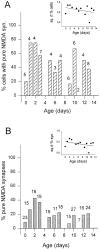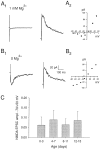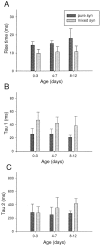NMDA EPSCs at glutamatergic synapses in the spinal cord dorsal horn of the postnatal rat
- PMID: 9698343
- PMCID: PMC6793215
- DOI: 10.1523/JNEUROSCI.18-16-06558.1998
NMDA EPSCs at glutamatergic synapses in the spinal cord dorsal horn of the postnatal rat
Abstract
In rat dorsal horn, little is known about the properties of synaptic NMDA receptors during the first two postnatal weeks, a period of intense synaptogenesis. Using transverse spinal cord slices from postnatal day 0-15 rats, we show that 20% of glutamatergic synapses tested at low-stimulation intensity in spinal cord laminae I and II were mediated exclusively by NMDA receptors. Essentially all of the remaining glutamatergic EPSCs studied were attributable to the activation of both NMDA and AMPA receptors. Synaptic NMDA receptors at pure and mixed synapses showed similar sensitivity to membrane potential, independent of age, indicating similar Mg2+ sensitivity. Kinetic properties of NMDA EPSCs from pure and mixed synapses were measured at +50 mV. The 10-90% rise times of the pure NMDA EPSCs were slower (16 vs 10 msec), and the decay tau values were faster (tau1, 24 vs 42 msec; tau2, 267 vs 357 msec) than NMDA EPSCs at mixed synapses. Our results indicate that NMDA receptors are expressed at glutamatergic synapses at a high frequency, either alone or together with AMPA receptors, consistent with the prominent role of NMDA receptors in central sensitization (McMahon et al., 1993).
Figures







References
-
- Bardoni R, Magherini PC, MacDermott AB. Magnesium sensitivity of synaptic NMDA receptors in rat spinal cord lamina I and II neurons during postnatal development. Soc Neurosci Abstr. 1996;22:797.
-
- Bardoni R, Magherini PC, MacDermott AB. NMDA receptor mediated synaptic transmission in rat spinal cord lamina I and II during postnatal development. Pflügers Arch. 1997a;434:R59.
-
- Bardoni R, Magherini PC, MacDermott AB. Some glutamatergic synapses on neurons in rat spinal cord lamina II are mediated by NMDA receptors alone. Soc Neurosci Abstr. 1997b;23:2284.
-
- Bessou P, Perl ER. Response of cutaneous sensory units with unmyelinated fibers to noxious stimuli. J Neurophysiol. 1969;32:1025–1043. - PubMed
-
- Carmignoto G, Vicini S. Activity-dependent decrease in NMDA receptor responses during development of the visual cortex. Science. 1992;258:1007–1011. - PubMed
Publication types
MeSH terms
Substances
LinkOut - more resources
Full Text Sources
